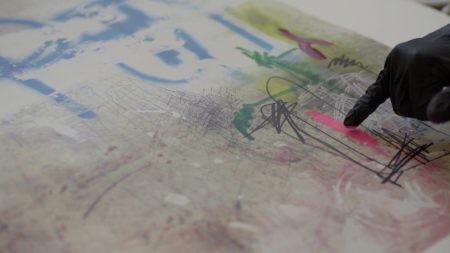Art historian, writer and curator Hector Campbell recently sat down with British artist George Morton-Clark to discuss his introduction to the development of his artistic practice, his love for animation, artistic influences and creative collaboration. George recently teamed up with art collective and production house Fluorescent Smogg to release his latest limited edition print, released in conjunction with Mirus Gallery.
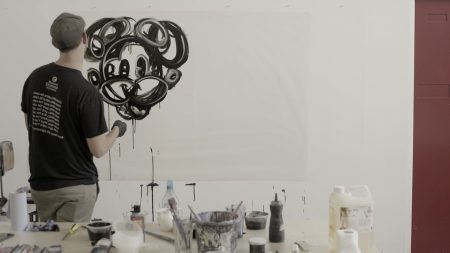
Hector Campbell (HC): Your early work explored the stresses, anxieties and paranoia evident within modern society through abstracted, deconstructed portraits. How do you approach the marriage of the conceptual and the physical within your practice? Are these early conceptual ideas still relevant to you?
George Morton-Clark (GMC): These conceptual ideas are still relevant, but I think they come out in a much more subconscious way now, whereas earlier in my practice it would be more obvious and easy to decipher. The way I used to approach my work was to not be so immediate, and consider the conceptual side of the process more than the physical creation of the work with the physical and more with the practice. I have learned over the years that when you start to think too much about your work you become rigid and the inner child is not able to express itself. I find myself today with more of a fluid process, feeling constipated with my ideas, and I have never been more happy with how I paint.
HC: Recent works have seen the incorporation of cartoon characters into your expressionist paintings – is this in part due to your background in animation, having studied the discipline at the Surrey Institute of Art and Design? Does that education still influence and affect your art making?
GMC: That is definitely true. I have always had a love for animation, hence why I did a degree in it, as I believe it is a portal for many children towards understanding the colours and movement of art. Like many other children growing up, I would draw my favourite characters, but for me it became on obsession. It was only many years later, after finding out about artists such as Andy Warhol, George Condo and Roy Lichtenstein that I realized I could continue doing this without being belittled by the art world.
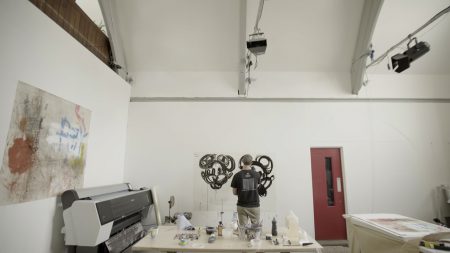
HC: Within your work, one can see aspects of many art historical movements: Abstract-Expressionism, Pop Art, Informalism and Street Art/Graffiti. What influence do other artists or art movements have on your work? And where do you see your work sitting within the current art discourse?
GMC: The influence of many of those you mentioned above are evident in my work. Just like music, where I like to listen to many varieties, I do not stay within one genre. It just so happens that I am a painter and I pick these styles up as I go along. I am sure if I was a musician you would be able to hear different influences in my work too. I get bored easy and like to always surprise myself in the course of my work. If it doesn’t feel fresh to me then I can easily become jaded with what I do. When I venture down a path I have never been down before, it gives me huge excitement and I fall in love with my work all over again. I have been known to get out of bed at 3am and go to the studio to work on an idea while it is fresh in my head.

HC: You’ve collaborated with both Knots Rugs and Penguin Books, seeing your artwork reproduced as a hand-knotted rug and a book cover respectively. How do you approach collaborations such as these? And what does it mean to see your work reproduced in such disparate mediums?
GMC: Collaborations are a great way to step out of your comfort zone, and working with Knots Rugs was a good example of that. To be honest the painting just becomes an idea, an image that I shared with the weavers from which they produce the spectacular rugs. Their skill and the final design is breathtaking. In this way, I see it as a big family of artists making an end product come to fruition.
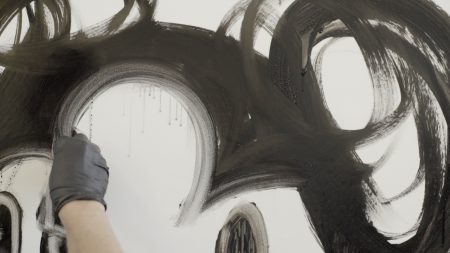
HC: In 2018 you were a part of a group exhibition at Artual Gallery in Beirut that entirely sold out. How did that feel? Does it provide a temptation to continue producing similar artworks, or are you still keen to explore and experiment as you see fit?
GMC: Like I previously said, unless I am in love with what I am doing, unless there is some passion, then I find it very hard to paint. Those works were great paintings and ideas but I felt that I had reached the end a bit and needed to start evolving the concept more.
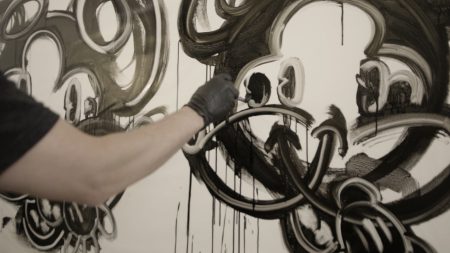
HC: Finally, could you tell us a little about the edition you have produced with Fluorescent Smogg? How have you found the collaborative process?
GMC: It has been great fun and I have learnt a lot about the process of printing. I went down to Bristol with Jonni Cheatwood (who was over from L.A. doing a residency in Berlin) who I knew from Beirut and who I’ve previously spent time with. He was also new to what we were walking into and so it was nice to share and bounce ideas off each other. We worked with an amazing printer called Jonny from Fluorescent Smogg, who could not have been more helpful in walking us through the process and where we needed to be at the end. I went in with a very solid idea and by the end, I was painting on acetate and doing something completely new to how I usually work but it was the perfect way to make the print work. I am so happy with the outcome, the quality was above and beyond my expectations!
